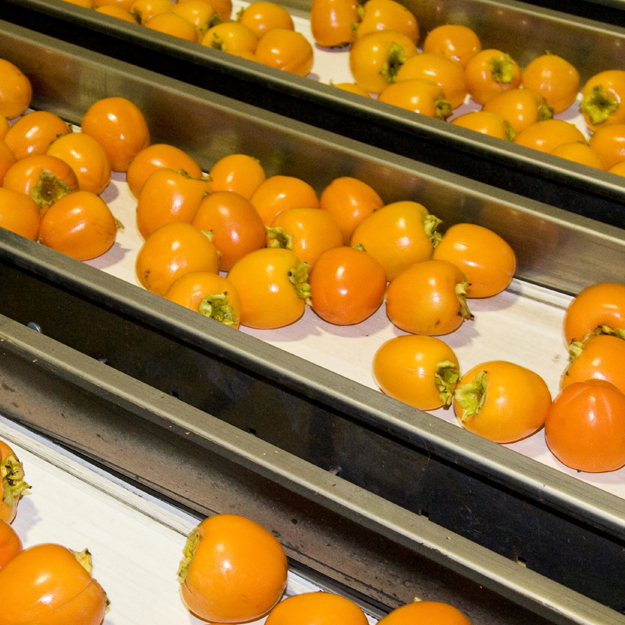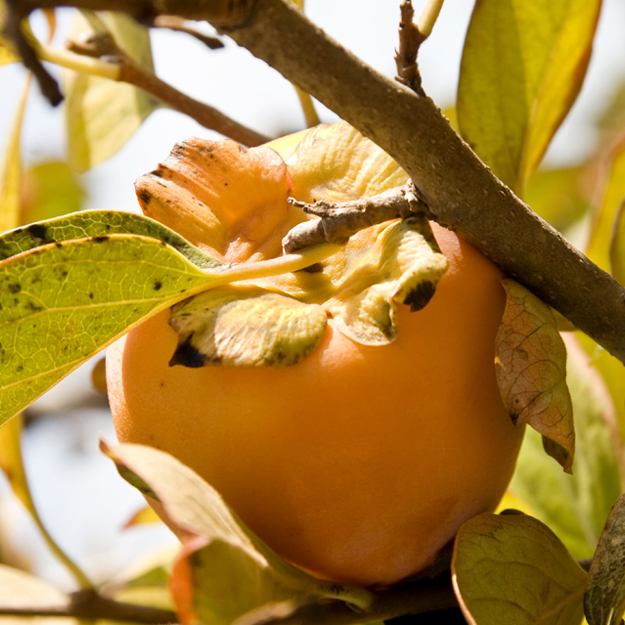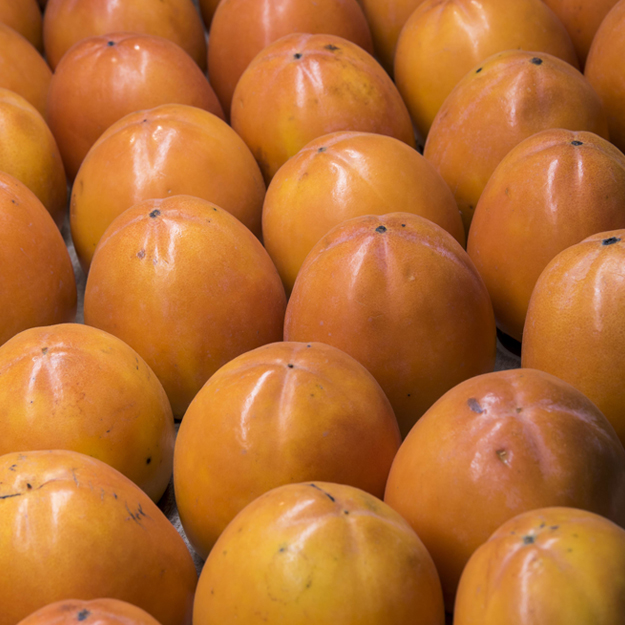.png.transform/rendition-xs/image_image%20(1).png)
Spanish Persimmons: the Sweetest Things!
Spain is the only country in the world to boast a quality guarantee for persimmons, the excellent product of PDO Kaki Ribera del Xúquer that has won over fans across the globe with its sweet and delicate flavor and brilliant orange-red flesh.
Persimmon season in Spain is fleeting, typically lasting from mid-October until January, a period of time that seems barely long enough for local and global fans of this Spanish fruit to get their fill. Even so, Spanish producers do what they can, exporting their fruit to Europe and beyond in quantities that reached approximately 75 million kilos during the 2017/2018 season. Spain is, in fact, the number one exporter of persimmons in the world, offering consumers a uniquely sweet fruit with firm flesh and virtually no astringency. To find this singular fruit, one need only look to the Ribera del Xúquer valley in Valencia, a region in which kakis (or caquis) – as persimmons are known here – thrive. The valley is characterized by the rich soils along the banks of the Júcar (Xúquer) and Magro rivers, and a mild climate and low rainfall. The crops are also protected against frost by the surrounding mountains, a factor that adds to the singular quality and traits of the persimmons that have been cultivated exclusively in this region.

Persimmons are produced here under Protected Designation of Origin Kaki Ribera del Xúquer, and are known around the world by the trademarked name Persimon®. Nearly half of the nearly 100 million kilograms of persimmons produced in Spain each year bear this prestigious quality guarantee. The PDO’s star variety is Rojo Brillante (Bright Red), an indigenous tree that was first discovered in Valencia some fifty years ago, and that is thought to have developed naturally in the area. Since then, the production of these golden-orange fruits has grown by leaps and bounds, in recent years edging out other local crops like lemons and oranges. Orange-yellow when harvested, this variety turns bright red as it ripens. It is typically larger and more elongated than most other varieties, and has a sweet and delicate flavor similar to that of a peach or a mango. It is also unique in its lack of astringency, meaning that, unlike other varieties of persimmon, it does not have to be overripe to be eaten, but can be consumed while still firm.
Persimon® abroad
Much of the success of this crop can be attributed to the current success enjoyed by Spanish persimmons beyond Spanish borders. Spain is the world's largest exporter of persimmons. This is thanks to the fact that the large majority of Persimon® production from Ribera del Júcar is exported, with these fruits making their way into markets throughout Europe and as far away as the United States, Saudi Arabia, Hong Kong, the U.A.E. and Brazil, among other countries. Three of the most important markets for Persimon® are the United Kingdom, Germany and Canada, countries that are currently being targeted by a special promotional plan by the Regulatory Board of PDO Kaki Ribera del Júcar in conjunction with ICEX and Foods from Spain, designed to highlight the distinctive features of these quality fruits.

In the UK, for example, sales of Spanish Persimon® have been increasing, with sales up by 20% in 2017 compared to the previous year. This translates to approximately 25 million fruits. These increases are due in large part to promotional efforts in this market that have been underway for some time, such as encouraging the use of Spanish kakis among Spanish businesses and UK-based Spanish chefs like José Pizarro, as well as activities including competitions, promotional events for the press and on social networks and more.
As far as Canada is concerned, Spain supplies upwards of 23% of Canadian persimmon imports, with nearly 69% growth in this market between 2012 and 2017, according to a study carried out by ICEX, Spain Trade and Investment. This increase can also be attributed to the growing significance that Canadian consumers place on natural and healthy products.
The collaboration between ICEX and PDO Kaki Ribera del Xúquer to promote this product beyond Spanish borders actually traces back to the year 2000. In the words of Rafael Perucho, the President of PDO Kaki Ribera del Xúquer, “Persimmons are a virtually unknown fruit, and therefore the campaigns to promote this fruit in principal European markets and other markets like the United States and Canada have been very important.”
Healthy, convenient, versatile
This trend towards responsible eating points to Spanish kakis as a perfect choice. This fruit is extremely rich in vitamins, minerals and antioxidants – as well as low in fat and high in fiber – and therefore chock-full of health benefits that include its being good for your heart. Even better, the unique characteristics of the Rojo Brillante PDO Kaki Ribera del Júcar are such that you can eat the fruit like an apple with the skin on, or peel it and slice off the top. The seedless and juicy flesh is ideal for children, and the fruit can be eaten whole or cut into wedges. Also, it is important to note that the brown speckles that appear occasionally on the fruits’ skin, are natural sugar freckles that indicate extra sweetness.

The delicious flavor and versatility of this fruit also mean that it is “ripe” for innovation and experimentation, not only in terms of cuisine, but also as new products. Some Spanish companies are starting to branch out into things like juices, jams and preserves, and there is even a line of oven-baked bite-sized snacks made with Ribera del Júcar Persimon®.
Thinking even further outside the box, a group of students studying Food Science and Technology degrees at the University of Miguel Hernández (Alicante province, the Valencian Community) recently presented a new fresh pasta product called Essenza di Vega at SIAL Paris, which was created using important products from the Spanish Mediterranean. Among them – persimmon flour. What else?
Text: Adrienne Smith / @ICEX
Photos: @ICEX

